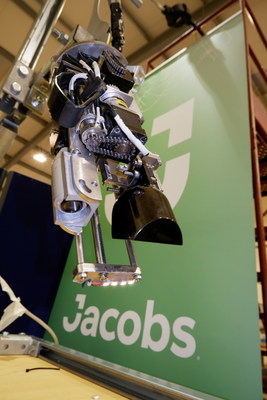Jacobs Builds Robot to Solve Debris Riddle in Damaged Fukushima Reactor
Jacobs (NYSE:J) has developed an innovative robotic tool designed to collect debris from the damaged Fukushima Daiichi nuclear reactor in Japan. Following the 2011 meltdown, this remotely operated device aims to gather crucial data about contamination levels. Successfully passing rigorous tests, the device will be tailored for radiation resistance in its final version. This advancement demonstrates Jacobs' commitment to addressing significant challenges in nuclear cleanup, with potential financial implications in project funding and safety enhancements.
- Development of a robotic tool for nuclear debris retrieval.
- Successful completion of demanding factory acceptance tests.
- Potential for significant project funding from Japan's Ministry of Economy, Trade and Industry.
- Uncertainty regarding the exact nature of debris and its implications.
Insights
Analyzing...
Harnessing innovation to support complex nuclear cleanup
DALLAS, May 25, 2022 /PRNewswire/ -- Jacobs (NYSE:J) has designed and built a robotic tool to obtain crucial information about the state of a damaged nuclear power reactor at Fukushima Daiichi in Japan.
The remotely operated device will collect pebble-like debris that was deposited at the bottom of the reactor containment vessel after the meltdown caused by the earthquake and tsunami in March 2011.
A prototype of the device has passed extremely demanding factory acceptance and performance tests to meet the requirements of Mitsubishi Heavy Industries (MHI), which is leading the project to develop the tool. It is expected that, following selection in Japan, a radiation resistant version will be built that will be able to carry out the important task of retrieving samples from the highly contaminated reactor.
"This is a prime example of how we are combining innovative engineering and deep nuclear knowledge to help decommissioning agencies meet the challenge of transforming legacy sites into a safe end state," said Jacobs Energy, Security & Technology Senior Vice President Karen Wiemelt.
The exact nature of the debris is currently unknown, and examination of the retrieved debris samples will provide crucial data for the next steps in the clean-up and decommissioning of the Fukushima reactors.
Designed by Jacobs' engineers in the U.K., the robotic tool had to meet more than 300 functional, operational, performance and geometric requirements. It also had to be small enough to enter the damaged containment vessel and pick up sand and pebbles up to 10 millimeters in size by deploying a bucket-style retrieval device.
Trials have shown that a remote operator, guided by images from a built-in camera, will need no more than eight minutes to insert the device into the containment vessel and retrieve debris samples, thus minimizing the impact of radiation damage on the functioning of the device.
MHI implemented this project through the International Research Institute for Nuclear Decommissioning, supported by funding from Japan's Ministry of Economy, Trade and Industry.
At Jacobs, we're challenging today to reinvent tomorrow by solving the world's most critical problems for thriving cities, resilient environments, mission-critical outcomes, operational advancement, scientific discovery and cutting-edge manufacturing, turning abstract ideas into realities that transform the world for good. With
Certain statements contained in this press release constitute forward-looking statements as such term is defined in Section 27A of the Securities Act of 1933, as amended, and Section 21E of the Securities Exchange Act of 1934, as amended, and such statements are intended to be covered by the safe harbor provided by the same. Statements made in this release that are not based on historical fact are forward-looking statements. When used herein, words such as "expects," "anticipates," "believes," "seeks," "estimates," "plans," "intends," "future," "will," "would," "could," "can," "may," and similar words are intended to identify forward-looking statements. We base these forward-looking statements on management's current estimates and expectations as well as currently available competitive, financial and economic data. Forward-looking statements, however, are inherently uncertain. There are a variety of factors that could cause business results to differ materially from our forward-looking statements, including, but not limited to, the timing of the award of projects and funding under the Infrastructure Investment and Jobs Act as well as general economic conditions, including inflation, changes in interest rates, foreign currency exchange rates, and changes in capital markets, geopolitical events and conflicts, and the impact of the COVID-19 pandemic, including the related reaction of governments on global and regional market conditions and the company's business, among others. For a description of some additional factors that may occur that could cause actual results to differ from our forward-looking statements, see the discussions contained under Item 1 - Business; Item 1A - Risk Factors; Item 3 - Legal Proceedings; and Item 7 - Management's Discussion and Analysis of Financial Condition and Results of Operations in our most recently filed Annual Report on Form 10-K, ,and Item 2 - Management's Discussion and Analysis of Financial Condition and Results of Operations; Item 1 - Legal Proceedings; and Item 1A - Risk Factors in our most recently filed Quarterly Report on Form 10-Q, as well as the company's other filings with the Securities and Exchange Commission. The company is not under any duty to update any of the forward-looking statements after the date of this press release to conform to actual results, except as required by applicable law.
For press/media inquiries:
Kerrie Sparks
214.583.8433
![]() View original content to download multimedia:https://www.prnewswire.com/news-releases/jacobs-builds-robot-to-solve-debris-riddle-in-damaged-fukushima-reactor-301554385.html
View original content to download multimedia:https://www.prnewswire.com/news-releases/jacobs-builds-robot-to-solve-debris-riddle-in-damaged-fukushima-reactor-301554385.html
SOURCE Jacobs









